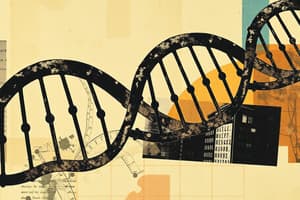Podcast
Questions and Answers
Match the following levels of gene regulation with their descriptions:
Match the following levels of gene regulation with their descriptions:
Epigenetic level = Regulation occurs when DNA is uncoiled and loosened from nucleosomes to bind transcription factors Transcriptional level = Regulation occurs when the RNA is transcribed Post-transcriptional level = Regulation occurs when the RNA is processed and exported to the cytoplasm after it is transcribed Translational level = Regulation occurs when the RNA is translated into protein
Match the following characteristics of proteins with their descriptions:
Match the following characteristics of proteins with their descriptions:
Polypeptides = Proteins are made up of polypeptides; a peptide is a short chain of amino acids Unique sequence of amino acids = Each protein has a unique sequence of 20 amino acids Polar amino acid side chains = Polar amino acid side chains tend to lie on the outside of the protein, interacting with water Hydrophobic core = Nonpolar amino acid side chains are buried on the inside, forming a tightly packed hydrophobic core hidden from water
Match the following protein structure components with their descriptions:
Match the following protein structure components with their descriptions:
Amino acids = Proteins are made up of amino acids; each protein contains about 35 amino acids in this schematic drawing Inside vs outside = Polar amino acid side chains lie on the outside of the protein, while nonpolar side chains are buried inside forming a hydrophobic core
Match the cell component with its function:
Match the cell component with its function:
Match the book title with its authors:
Match the book title with its authors:
Match the programming languages with their primary usage:
Match the programming languages with their primary usage:
Match the scientific journal with its content:
Match the scientific journal with its content:
Match the type of sugar with the nucleotide it gives:
Match the type of sugar with the nucleotide it gives:
Match the following terms with their definitions:
Match the following terms with their definitions:
Match the footnotes content with their description:
Match the footnotes content with their description:
Match the following components with their roles in biosensors:
Match the following components with their roles in biosensors:
Match the following terms with their fields of application:
Match the following terms with their fields of application:
Match the following phrases with their descriptions:
Match the following phrases with their descriptions:
Match the following with their descriptions:
Match the following with their descriptions:
Match the following categories of sensing elements with their mechanisms of interaction:
Match the following categories of sensing elements with their mechanisms of interaction:
Match the following examples with their types of sensing elements:
Match the following examples with their types of sensing elements:
Match the following components with their functions in a biosensor:
Match the following components with their functions in a biosensor:
Match the following terms with their roles in biosensors:
Match the following terms with their roles in biosensors:
Match the following concepts with their applications in biosensors:
Match the following concepts with their applications in biosensors:
Match the following components with their roles in a parallel plate capacitor:
Match the following components with their roles in a parallel plate capacitor:
Match the following terms with their definitions in relation to an electrolyte-gated FET:
Match the following terms with their definitions in relation to an electrolyte-gated FET:
Match the following statements with their correct implications regarding a parallel plate capacitor:
Match the following statements with their correct implications regarding a parallel plate capacitor:
Match the following properties with their impact on a double-layer capacitor in an FET:
Match the following properties with their impact on a double-layer capacitor in an FET:
Match the following descriptions with their correct components within a parallel plate capacitor system:
Match the following descriptions with their correct components within a parallel plate capacitor system:
Match the following concepts with their relevance to maximizing drain current in a transistor:
Match the following concepts with their relevance to maximizing drain current in a transistor:




